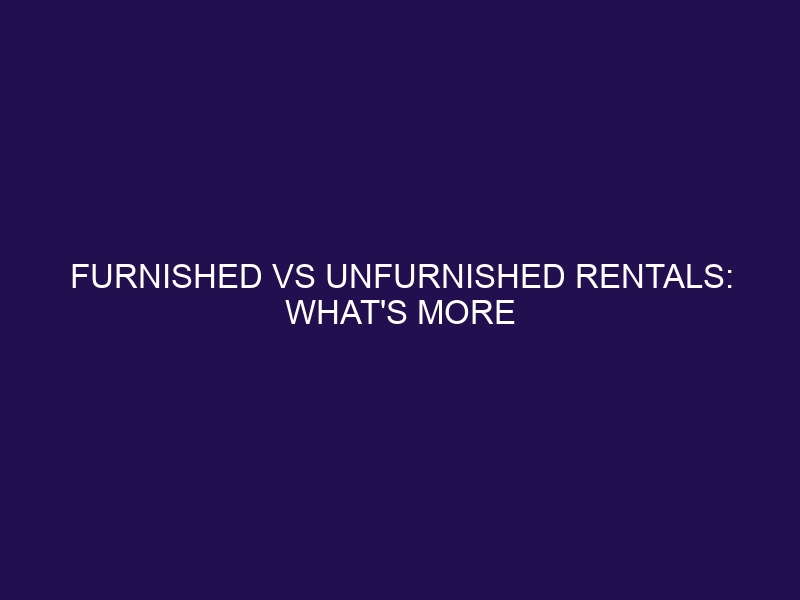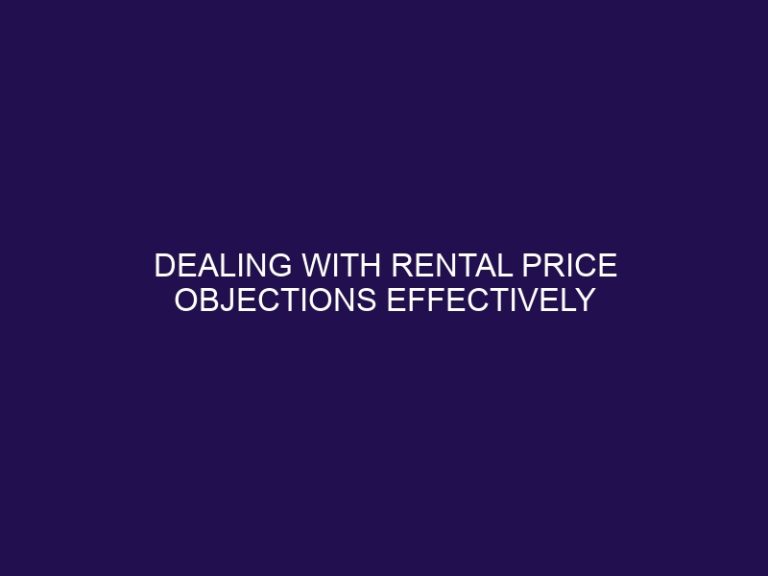Furnished vs Unfurnished Rentals: What’s More Profitable?
When it comes to renting out a property, two options that landlords often consider are furnished or unfurnished rentals. Furnished rentals come with all necessary furniture and appliances, while unfurnished rentals are typically empty except for major appliances like a refrigerator and stove. While both options have their advantages and drawbacks, landlords must determine which type of rental will be more profitable for their specific property and target market.
Furnished rentals are fully equipped and move-in ready for tenants. They often include items such as beds, sofas, dining tables, and kitchenware. On the other hand, unfurnished rentals typically only include major appliances and allow tenants to bring in their own furniture and decor.
Furnished rentals have several benefits for both landlords and tenants. For landlords, they can charge a higher rent, have a lower vacancy rate, and attract short-term tenants such as tourists or professionals on temporary job assignments. Tenants benefit from the convenience and cost-saving of not having to purchase and move furniture.
However, there are also drawbacks to furnished rentals. They require a larger upfront investment and continual upkeep of furniture and appliances. Tenants may also be more likely to cause damage to the furniture, resulting in additional costs for the landlord.
Unfurnished rentals, on the other hand, may have a lower upfront cost for landlords and require less maintenance. They also attract long-term tenants who are more likely to take care of the property. However, unfurnished rentals typically have a lower rent and a longer vacancy rate.
When it comes to determining which type of rental is more profitable, landlords must consider various factors such as the location, target market, and competition. For example, in a city with a high demand for short-term rentals, a furnished rental may be more profitable. However, in a suburban area with primarily long-term tenants, an unfurnished rental may be the better option.
Case studies and examples have shown that both furnished and unfurnished rentals can be profitable. In some cases, landlords have seen higher profits with furnished rentals due to the ability to charge a higher rent and attract short-term tenants. However, in other cases, landlords have found more success with unfurnished rentals as they have lower maintenance costs and longer tenancy periods.
In conclusion, both furnished and unfurnished rentals can be profitable, and the best option for a landlord depends on various factors. It is essential to consider the location, target market, and competition when making this decision. Ultimately, landlords must determine which type of rental will be more profitable for their specific property and goals.
What are Furnished Rentals?
What are Furnished Rentals?
Furnished rentals are properties that come equipped with essential furniture and appliances, making them convenient and appealing for individuals seeking temporary accommodation. This could include students, professionals on short-term assignments, or individuals who are relocating for a limited period of time.
What Are the Benefits of Furnished Rentals?
What Are the Advantages of Furnished Rentals?
Furnished rentals offer numerous benefits, including convenience and cost savings for tenants who do not have to worry about furnishing the property. They also provide flexibility for short-term stays and are appealing to those seeking a hassle-free move. These rentals are particularly attractive for corporate relocations, students, and individuals in need of temporary accommodation.
What Are the Drawbacks of Furnished Rentals?
Drawbacks of furnished rentals include:
- Higher rental costs
- Potential for more wear and tear on furniture
- Limited personalization
- The need for frequent maintenance
These are important factors to consider when deciding between furnished and unfurnished rentals.
What are Unfurnished Rentals?
Unfurnished rentals are properties that do not come equipped with furniture or appliances. Tenants are responsible for providing their own furnishings, making these rentals perfect for individuals who already have furniture or desire a customized living space.
What Are the Benefits of Unfurnished Rentals?
Unfurnished rentals provide numerous benefits for tenants. They offer the freedom to personalize living spaces, eliminate the need to purchase furniture, and provide a long-term housing solution. Furthermore, these rentals typically have lower monthly rental fees, making them a more budget-friendly option for tenants.
What Are the Drawbacks of Unfurnished Rentals?
Unfurnished rentals may require a higher initial investment and have a limited tenant pool due to the need for furniture. There is also the potential for maintenance costs. However, these rentals offer greater personalization and have the potential to attract long-term tenants, ultimately leading to financial benefits for landlords.
A true story: A property owner initially faced challenges with their unfurnished rental due to the smaller tenant pool. However, after making minor adjustments and marketing the property as a ‘blank canvas,’ they were able to attract a long-term tenant who was willing to pay a higher rent for the opportunity to customize the space.
What are the Key Differences between Furnished and Unfurnished Rentals?
When it comes to renting out a property, landlords are faced with the decision of whether to offer a furnished or unfurnished option. Each option has its own set of advantages and disadvantages, making it a difficult choice for property owners. In this section, we will discuss the key differences between furnished and unfurnished rentals. From upfront costs to target market and flexibility for tenants, we will explore the factors that can impact the profitability of each choice.
1. Upfront Costs
- Initial Deposit: Consider the upfront costs, including the security deposit, first and last month’s rent.
- Furniture Costs: Account for purchasing or renting furniture and appliances.
- Maintenance: Budget for potential repairs and replacements.
2. Target Market
The target market for furnished rentals includes corporate professionals, students, and individuals seeking temporary accommodation.
Unfurnished rentals cater more to long-term tenants, families, and individuals who prefer personalizing their living space.
Pro-tip: Understanding your target market helps optimize rental offerings for maximum profitability.
3. Maintenance and Upkeep
- Regular Inspections: Schedule routine check-ups to identify and address maintenance and upkeep needs.
- Prompt Repairs: Quickly attend to any reported issues to prevent further damage and maintain the property’s functionality.
- Cleaning Services: Arrange for regular cleaning to maintain the property’s appeal and functionality, ensuring a positive tenant experience.
- Landscaping: Keep the outdoor areas well-maintained to enhance the property’s visual appeal and provide a positive tenant experience.
A diligent property owner conducted regular maintenance and upkeep, resulting in long-term tenant satisfaction and positive referrals.
4. Flexibility for Tenants
In furnished rentals, tenants can enjoy flexibility as they are not burdened with the task of purchasing and moving furniture.
On the other hand, unfurnished rentals give tenants the freedom to personalize their living space according to their preferences, providing an additional level of flexibility for tenants.
Which Type of Rental is More Profitable?
As a landlord or property investor, the decision to rent out a furnished or unfurnished property can greatly impact your profitability. In this section, we will discuss the various factors that should be considered when deciding between a furnished or unfurnished rental. Additionally, we will examine real-life case studies and examples to gain a better understanding of which type of rental yields higher profits in different scenarios.
1. Factors to Consider
- Location: Evaluate demand for furnished vs. unfurnished rentals in the area.
- Target Market: Understand the preferences and needs of potential tenants.
- Finances: Consider initial costs, potential rental income, and long-term profitability.
2. Case Studies and Examples
Case studies and examples are powerful tools in understanding the profitability of furnished versus unfurnished rentals. By analyzing rental income, occupancy rates, and tenant turnover in various locations, valuable insights can be gained. Additionally, examining real estate market trends and learning from landlord experiences can further enhance one’s understanding of rental profitability.
Frequently Asked Questions
Is it more profitable to rent out a furnished or unfurnished property?
It ultimately depends on your investment strategy and the needs of your target renters. Furnished apartments have the potential for higher rental income and security deposits, as well as a niche tenant pool with higher demand. However, there is a higher initial investment and potential for loss or damage. Unfurnished properties have lower maintenance costs and upfront investment, and allow tenants to customize the space.
What are the major pros and cons of renting out a furnished property?
The major benefits of a furnished property include higher potential for rental income and security deposits, as well as a niche area with higher demand. However, there is a higher initial investment and potential for damage to and loss of furnishings. Additionally, furnished properties may have limited flexibility for tenants who already have their own furniture.
What factors should be considered when deciding between furnishing or not furnishing a rental property?
The decision between furnishing or not should be based on the location, target market, and competition, as well as your investment strategy. Furnishing a rental property can attract higher quality tenants who are willing to pay more for convenience, but landlords should also consider the cost of furnishing and the potential for damage or loss of furnishings.
What are the potential benefits and drawbacks of a semi-furnished apartment?
Semi-furnished apartments offer a middle ground between fully furnished and unfurnished properties. They may attract a wider range of renters, as they come with basic big pieces of furniture but not all necessary furnishings. However, landlords should carefully consider the cost and condition of furnishings, as well as the potential for damage or loss of these items.
Is it common for landlords to provide a welcome package for tenants in furnished rentals?
Providing a welcome package with basic household items, such as kitchen utensils, hand and dish soaps, and cleaning supplies, can be a nice touch for tenants in furnished rentals. However, this is not a deciding factor for most renters and may vary widely among landlords.
What should a landlord do if a tenant has personal preferences for furniture in a furnished rental?
If a tenant has personal items or furniture they wish to bring into a furnished rental, it is not uncommon for landlords to allow this and make arrangements in the lease agreement. Landlords should consider the needs of their renters and be reasonable when discussing any changes to the furnishings.







